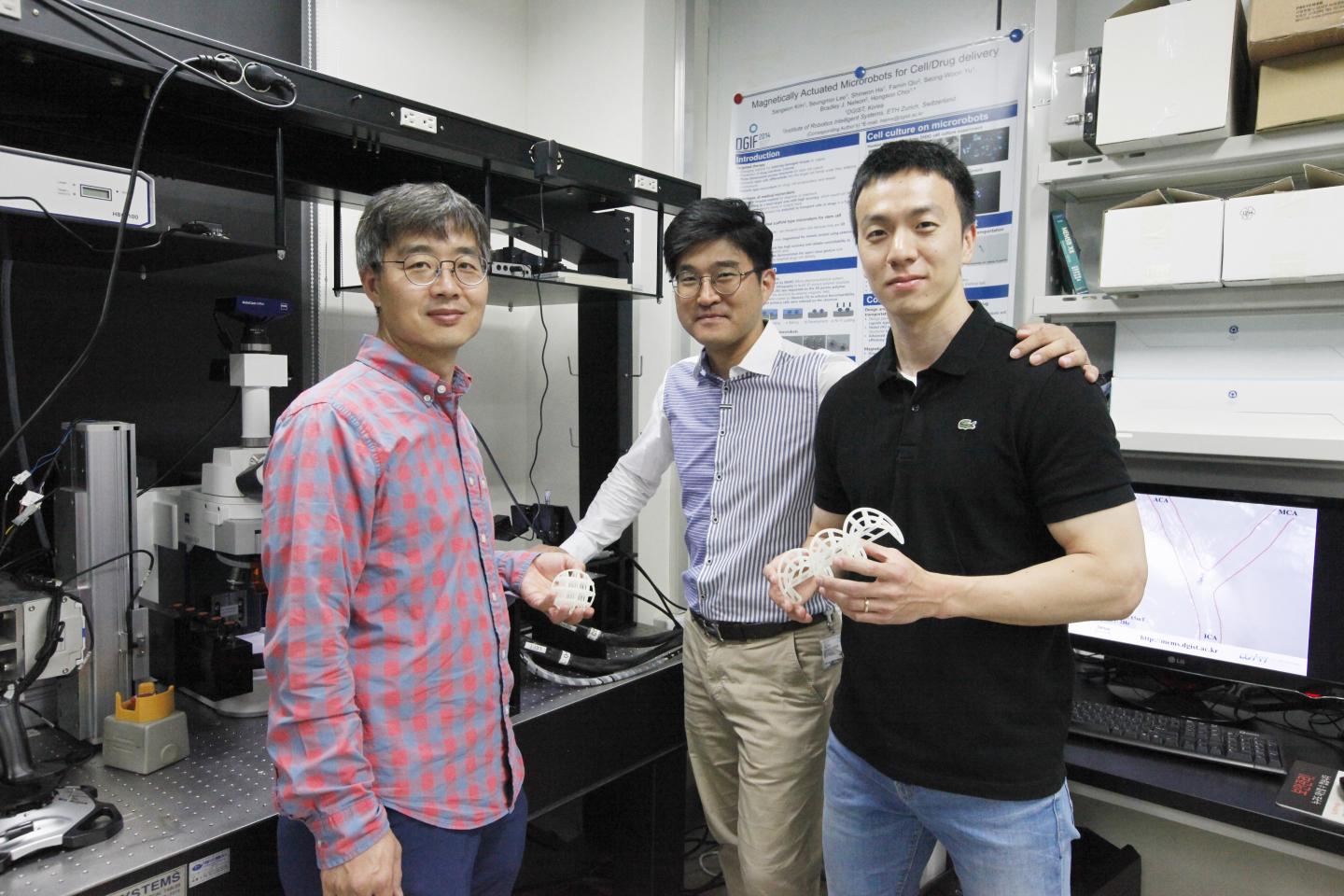Successful development of magnetically-actuated microrobots as a platform for stem cell transplantation

Credit: DGIST
DGIST research team succeeded in developing stem cell delivery of scaffold1 microrobot that can precisely deliver cells to a target body tissue. This research achievement is expected to enhance the treatment safety and efficiency of degenerative neural disorders as it can precisely transplant the exact amount of stem cell-based treatment cells to human body tissues and organs.
DGIST recently announced that Professor Hongsoo Choi’s team in the Department of Robotics Engineering developed a ‘scaffold microrobot for stem cell delivery and transplantation,’ which can further enhance the existing treatment efficiency of stem cell. A joint international research was conducted with Senior Researcher Jin-young Kim at DGIST-ETH Microrobot Research Center, Professor Seong-Woon Yu and Professor Cheil Moon’s team in the Department of Brain and Cognitive Sciences, Professor Sung Won Kim’s team in Seoul St. Mary’s Hospital, and Professor Bradley J. Nelson’s team in the Institute of Robotic and Intelligent Systems at ETH, Zurich, Switzerland.
Stem cell treatment has been taking limelight as a regenerative medical technique for intractable disorder treatment, but it cannot transplant the exact amount of stem cells to the target areas in need of treatment deeply inside body or may carry injection risk. It has especially been pointed out that treatment efficiency and safety are low due to huge loss during the in vivo delivery of stem cells and a high cost of treatment.
To overcome such limitation, the DGIST research team devised scaffold microrobot in a spherical and helical type through the 3D laser lithography2. The biggest achievement of this study is that it minimized cell loss in the body through a wireless control method using an external magnetic field while transplanting stem cells quickly and precisely at the same time.
What is noteworthy is that while the existing researches tested microrobots in a static external environment and not physiological environment, this research cultured a hippocampal neural stem cell3 on a microrobot for the first time in the world. They divided the cell into specific cells such as astrocyte4, Oligodendrocyte5, and neuron6 and succeeded in precisely delivering and transplanting them in the target.
To gain this achievement, the research team showed the cell transfer and transplantation process using the microrobot inside Body-on-a-chip (BOC), a microfluidic cell culture system that replicated a physiological in vivo environment. They also extracted a rat’s brain and injected the microrobot into the internal carotid artery7, and transferred it to the anterior cerebral artery8 and middle cerebral artery9 using outer magnetic field. A highlight of this joint research is that they cultured the ‘hNTSCs10‘ provided by Professor Sung Won Kim’s team at the Catholic University St. Mary’s Hospital on the microrobot in 3D for successful experiment.
Professor Hongsoo Choi at the Department of Robotics Engineering said “Through this research we hope to increase the treatment efficiency and success rate for Alzheimer and central neural diseases, which couldn’t be approached through the existing method of stem cell treatment. Through continuous follow-up research with hospitals and related companies, we will do our best to develop a microrobot-based precise treatment system that can be used in actual hospital and clinical sites.
###
This experiment result was published on May 30th issue of ‘Science Robotics,’ a top international journal in robot research field and the sister magazine of ‘Science,’ a world-renowned scientific journal. This research was also supported by the Ministry of Science and ICT and the Ministry of Trade, Industry, and Energy.
- 1 Scaffold: A porous cell support structure that helps cells attach and grow well and can hold many cells on a small surface.
2 3D laser lithography processing: A method of stepper exposure, 780nm wavelength laser with a short femtosecond pulse of 100 fs is exposed to a photoresist. It make possible to construct a sophisticated structure with a 3D structure without a mask.
3 Hippocampal neural stem cell: As the neural stem cells of the hippocampus located inside the cotyledons of the brain, neural stem cells are able to self-replicate and have the ability to differentiate into neural stem cells
4 Astrocyte: Characteristic star-shaped glial cells in the brain and spinal cord (central nervous system).
5 Oligodendrocyte: Provides support and insulation to axons in the central nervous system of some vertebrates.
6 Neuron: A unit of nerve cell in charge of stimulation and excitement.
7 Internal carotid artery (ICA): A major-paired artery, one on each side of the head and neck in human anatomy that supplies blood to the brain.
8 Anterior cerebral artery (ACA): Last part of internal carotid artery that supplies oxygenated blood to the most midline portions of the frontal lobes and superior medial parietal lobes.
9 Middle cerebral artery (MCA): One of the three major-paired and biggest internal carotid arteries that supply blood to the cerebrum.
10 hNTSCs : Human nasal turbinate derived stem cells
Media Contact
Hongsoo Choi
[email protected]
Original Source
https:/
Related Journal Article
http://dx.




